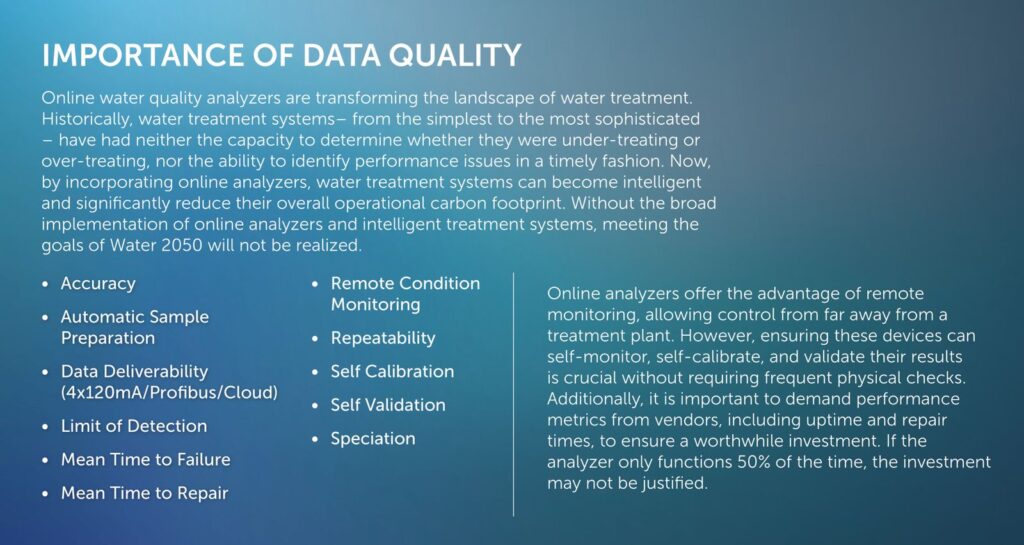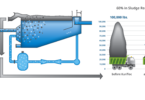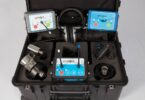Online instrumentation, once a niche segment of the broader water quality analysis market, is poised for significant growth. As an industry governed by regulatory standards to deliver safe water and protect environmental health, we are challenged to do so cost-effectively with minimum greenhouse gas (GHG) emissions. While new treatment facilities can be built, a greater focus should be placed on making the legacy of inefficient and non-climate-friendly treatment plants more sustainable and aligned with the goals of Water 2050. Online water quality analyzers will be instrumental in helping existing water treatment facilities meet these goals because of the benefits they offer. Real-time water monitoring helps optimize the treatment process, resulting in less energy and chemical use, and therefore, less GHG emissions.
Drivers for Online Water Quality Analysis
While laboratory-based analysis historically has been used to monitor water quality for inorganic, organic, and trace metal contaminants, online analyzers offer considerable advantages for minimizing carbon footprint at existing treatment facilities designed without the climate in mind.
Improve Accuracy and Reliability of Results
The performance of online analyzers is much more accurate and precise than laboratories themselves. Whereas most standards for laboratories allow for plus or minus 20 percent (±20%) in terms of accuracy and precision of results, online analyzers provide water quality results plus or minus 10 percent (±10%). The accuracy and precision of analytical results are important factors because this data drives operational and compliance decisions.
Increase the Frequency of Sampling
The infrequent data sets from manual laboratory sampling offer little insight for facilities to proactively manage, control, and mitigate contaminants of concern. The high frequency of automated sampling, analysis, and reporting available through online analyzers offers great potential for onsite or remote process control automation and for making management decisions on water quality at the source, intake, discharge, treatment plant, and distribution system to drive sustainable operations.
Shorten the Time to Results
Water treatment systems are subject to a wide range of factors that produce unpredictable changes in water quality. Operational control is contingent not only on the accuracy and reliability of water quality results but also on timely ones. It can take a laboratory anywhere from a few days to a few weeks to provide results, which makes it very difficult to control the process when data is not available. Meanwhile, the high-frequency real-time data from an online analyzer will provide the necessary information within minutes or hours to support immediate action and sustainable operation.
The Value of Real-Time Water Quality Data
Real-time water quality monitoring immediately impacts reducing the GHG emissions of existing treatment plants. The efficiency gains enabled by real-time insights allow operators to reduce net water intake, improve compliance, and reduce downstream pollution. Overall, it saves utilities time and money and helps them contribute to a positive water future where negative environmental impacts are minimized.
Characterization
Characterizing water quality data in real-time provides valuable insights into the dynamic conditions of a water treatment system. Facilities can make informed decisions by monitoring daily variations in contaminant levels and treatment performance. This real-time visibility enables a better understanding of challenges and operational effectiveness, helping to optimize investments and enhance overall system performance.
Validation
Real-time data is essential for making informed decisions before investing in new technologies, ensuring they meet performance and sustainability expectations while effectively treating contaminants. It also provides immediate insights into system performance and reliability, helping to validate technology performance. This approach allows operators to monitor how technologies respond under various parameters and conditions over time.
Optimization
Online data plays a crucial role in optimizing plants by providing real-time information that helps in decision-making. This data enables operators to identify inefficiencies and adjust processes promptly, ensuring standards are met without excessive treatment. With real-time water quality data, facilities can minimize the costs associated with over-treatment while ensuring compliance with regulations. Leveraging online data leads to a more efficient, effective and sustainable optimization strategy in plant operations.
Risk Management
Online water quality data is crucial for effective risk management. It enables continuous monitoring, alerting operators immediately when a critical component fails. It is no longer acceptable to have environmental damage caused by treatment system failures that go undetected through a lack of real-time controls. Real-time data allows for establishing alarms that can automatically shut down the treatment system, prompting swift interventions to mitigate risk and reduce potential costs associated with system failures. This proactive approach enhances the safe delivery of water and helps maintain operational integrity.
The Impact of Online Analyzers and Their Support of Water 2050 Goals
Online water quality analyzers are transforming the landscape of water treatment. Historically, water treatment systems– from the simplest to the most sophisticated – have had neither the capacity to determine whether they were under-treating or over-treating, nor the ability to identify performance issues in a timely fashion. Now, by incorporating online analyzers, water treatment systems can become intelligent and significantly reduce their overall operational carbon footprint. Without the broad implementation of online analyzers and intelligent treatment systems, meeting the goals of Water 2050 will not be realized.

Contact Rick Bacon for more information.








